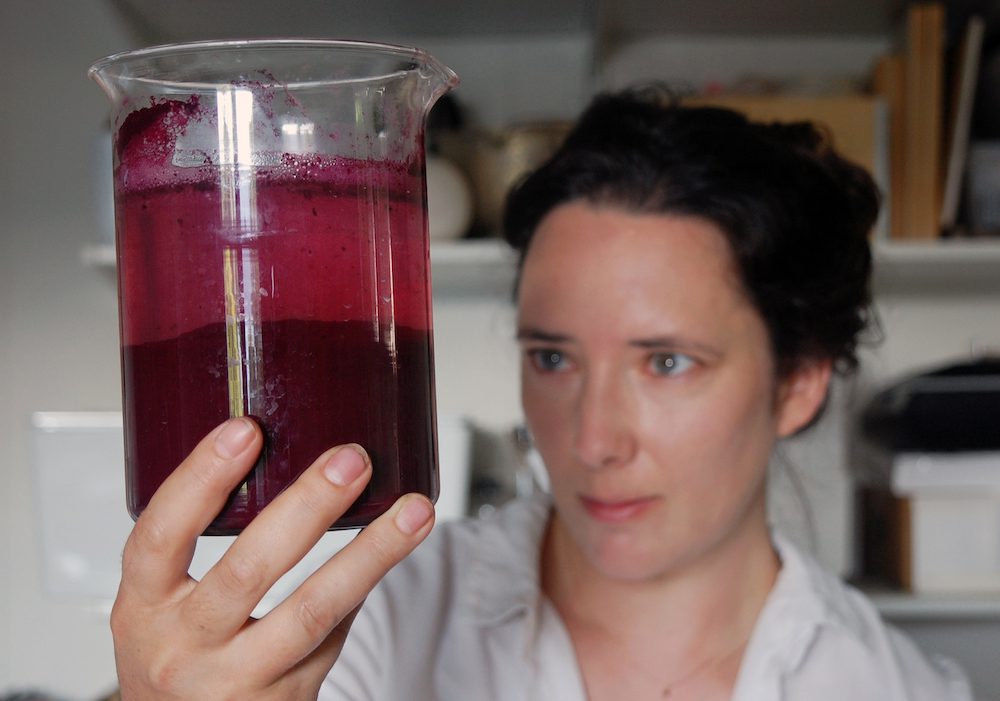
This week for Sunday Visit, we caught up with artist and educator Natalie Stopka (the mad scientist of lake pigments), in her upstate New York studio. In said studio, there are jars and vials of unusual color and tools for making extraordinary art.
Natalie is pretty darn clear that these jars aren’t for show.
They’re not time capsules of color.
They’re 100% for making art and pushing what color and pigment can do.
And after following her for years, we also love the dichotomy that is Natalie Stopka. That she loves lightfastness and fading.
That she can talk about synthetic and organic in the same sentence.
That she can admit, and even flaunt on social media, her mistakes making color but the exploration in taking the wrong turn.
She also has the greatest sense of humor and we think she should be a stand-up comedian. Truth.
What are you really into making right now and why?
Right now I’m really into abundance. What plants are the most abundant in my neighborhood, and do they contain dye colorants? Even though those plants may be invasive species, common weeds, or kitchen waste which may not be mentioned in conventional dye manuals, if they contain color I want to figure out how to use it. And not just to express myself, but to express the beauty of this place and gratitude for abundance!
How have you evolved as an artist since your natural dye journey began?
I’ve always had a stout respect for lightfastness. And, with practice, I’ve come to understand the factors contributing to longevity, so when needed I can produce the highest possible UV resistance.
But I’ve also recently been cultivating respect for fading. Bear with me – fading has a bad reputation. But there are projects where utmost lightfastness needn’t be a primary goal. I always ask myself:
What is the lifespan of this item?
How much time will it be exposed to sunlight?
Would I rather have a brief experience of a glorious color that expresses something particular and poignant and eventually changes, or none at all?

Give us 3 fun facts about lake making.
1. Every time you dye an alum-mordanted fiber, you’re making a lake pigment! It’s attached to the fiber, and it’s how the water-soluble dye is transformed into washable, insoluble color. In a lake pigment workshop, you learn to complete that process without the fiber getting involved. The color can then be used for many other applications and substrates.
2. When making a lake pigment from a natural dye, you can control the hue, saturation, and value. Also, whether it’s translucent or opaque! This is really useful when considering what type of artists’ materials you’ll create from the lake pigment.
3. The term ‘lake pigment’ isn’t a highly refined bit of chemical etymology; it’s a mistranslation. The name of the lac insect (whose resinous red and damson-purple excretions we dyers love) is a Hindi word. Coincidentally, lac is also a French term meaning ‘lake’. At some point, an English-speaker mistook the Hindi lac for the French one. Lac makes gorgeous lake pigments.
Thanks Natalie!
Join Natalie Stopka September 23 & 24 for Invasive and Ruderal Local Color. Natalie will explore the pigment potential of ruderal (a plant growing on waste ground or among refuse) and invasive plants to make lake pigments. This is an online workshop and will be recorded.
Want to see more of Natalie? Check out the FEEDBACK FRIDAY she did here and a more recent one with Tilke Elkins here.
